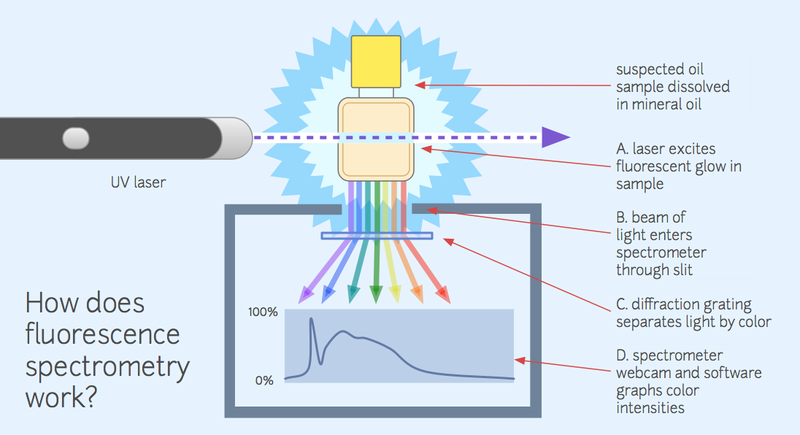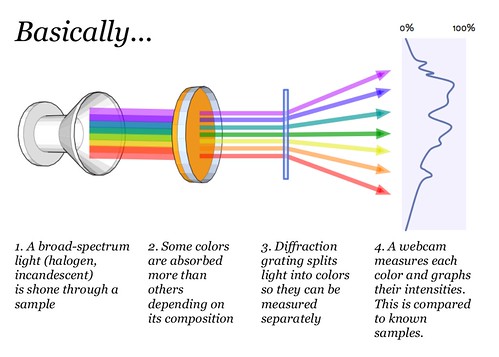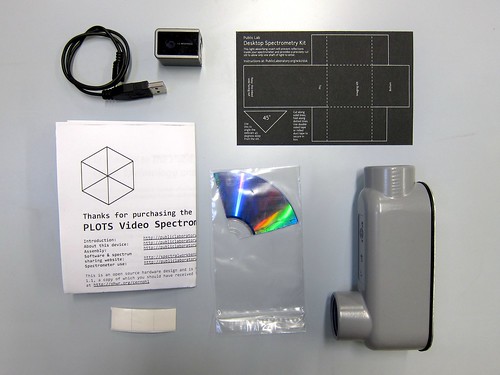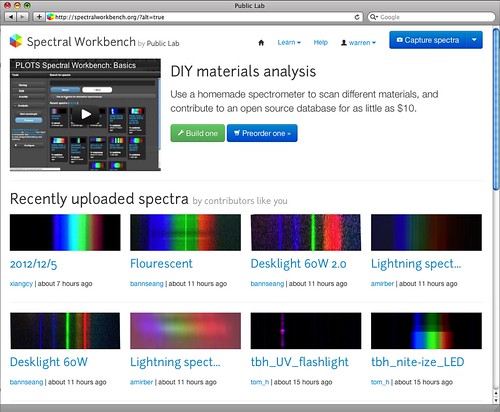
Spectrometer
Quick Links
- contributed open-source Spectrometry research
- Foldable Mini-Spectrometer
- Desktop Spectrometry Kit
- Spectral Workbench - software for using your DIY spectrometer
- Spectral Workbench usage - support for our spectrometry software
DIY Spectrometry mailing list
Subscribe to the "plots-spectrometry" mailing list for support, discussion, and to share your work:
Purpose
Chemists use expensive tools called spectrometers (there are several kinds) to analyze unknown solid or liquid samples.
We are working on a cheap version which we hope to use to identify oil contamination in water and soil, as well as a range of other possible toxins.
Spectrometers can also be used to identify species of plants or crop diseases, assess plumes from smokestacks, and have many other applications.

What's spectrometry?
What we perceive as a single color consists of multiple blended colors- just as green paint can be made from mixing yellow and blue paint. A spectrometer is a device that splits light into the various colors it is composed of, which we otherwise cannot distinguish with the naked eye. By viewing a substance through a spectrometer, one can distinguish the exact mixture of colors, which correspond to specific wavelengths of light. These can be compared to other spectra to help identify the sample.
Make a spectrometer
The PLOTS spectrometer is a Do-it-Yourself tool made from simple materials:
- stiff black card paper
- a clean DVD-R
- an HD USB webcam
- a Type LB conduit body
- double-sided foam tape and a box cutter/x-acto knife
The DVD's tightly packed grooves act as a diffraction grating -- basically a prism.
Spectrometer construction »
The above link offers step-by-step instructions on making your own spectrometer. It features:
- around 400-900 nanometer range, maybe wider (what you can see with the naked eye, plus some infrared)
- 5-10 nm spectral resolution
- 20-30 samples per second
- ~ $15 in materials
- < 1 hour construction time
- open-source software
Though these specs look pretty good, they still need to be compared rigorously with a traditional laboratory spectrometer. Are you interested in trying it?
Uses for open source spectrometry
As we ship to the different Kickstarter backers, we are posting how people have said they plan to use their spectrometers.
One group of toxins common to fossil fuel contamination are PAHs, polycyclic aromatic hydrocarbons, which are generally carcinogenic. We're trying to develop a step-by-step experimental procedure to prepare a soil or water sample, shine a full-spectrum light (like a halogen lamp) through it, and detect the missing wavelengths.
If you're interested, please chip in to develop and document a consistent way to read samples here:
Spectrometer usage »
We're also putting together a list of research (some of it our own) to draw upon in developing spectral analysis techniques for anything from soil to grapes to coffee:
Spectral Analysis »
Online spectral analysis
Along with the physical tool itself, the PLOTS community has also developed a software suite and online database which allows anyone to upload their data and work with others to try to interpret it. These tools are early prototypes and we're looking for help developing them.
Finally, a FAQ with some insights about actually using your spectrometer can be found here:
Goals
This is an early-stage, speculative project, but our goals include:
- Identify a contaminant in a sample, like a polycyclic aromatic hydrocarbon -- i.e. naphthalene, anthracene or tetracene. Tetracene has absorption bands well into the visible range.
- Identify a plant species by its spectrum. (see this helpful paper by Zomer et al) Or perhaps a mineral, using the ASTER spectral library
- Try to identify something in a smokestack plume, like a refinery plume
Older designs
Several older designs have been documented on this site. Guides have been made showing you how to make some of these; they include:
- plots-spectrometer-guide-small.pdf - by the PLOTS team for our workshop at the Whitney Museum
- Make a Spectrometer.pdf - by Alex McCarthy
- partsandcrafts-spectrometer-guide.pdf - by Parts and Crafts (21mb, print quality)


